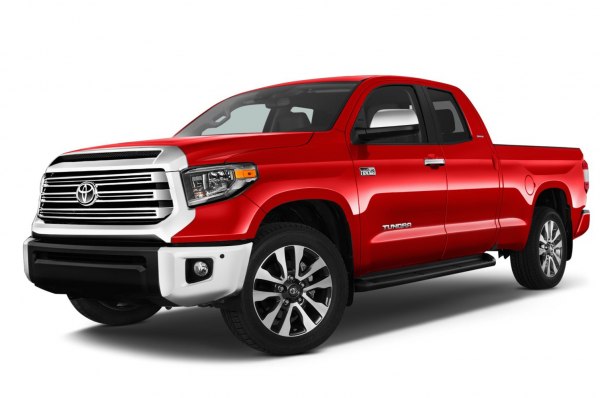









| Welcher Typ ist die Karosserie, Toyota Tundra II Double Cab Standard Bed (facelift 2017)? | Pick-up, 4 Türen, 5 Sitze |
|---|---|
| Wie hoch ist der Kraftstoffverbrauch, Toyota Tundra II Double Cab Standard Bed (facelift 2017) 4.6 V8 (310 Hp) 4x4 ECT-i? | 14.7 l/100 km 16 US mpg 19.2 UK mpg 6.8 km/l |
| Wie ökologisch ist das Auto, Toyota Tundra 4.6 V8 (310 Hp) 4x4 ECT-i? | LEV-II; ULEV-II |
| Was ist die Motorleistung, Toyota Tundra Pick-up 2017 4.6 V8 (310 Hp) 4x4 ECT-i? | 310 PS, 443 Nm 326.74 lb.-ft. |
| Was ist die Motorgröße, Toyota Tundra Pick-up 2017 4.6 V8 (310 Hp) 4x4 ECT-i? | 4.6 l 4608 cm3 281.2 cu. in. |
| Wieviel Zylinder hat der Motor, 2017 Toyota 4.6 V8 (310 Hp) 4x4 ECT-i? | 8, V-Motor |
| Was ist der Antrieb, Toyota Tundra II Double Cab Standard Bed (facelift 2017) Pick-up 2017 4.6 V8 (310 Hp) 4x4 ECT-i? | Allradantrieb (4x4). Verbrennungskraft-maschine. Die VKM treibt die Hinterräder permanent an und die Vorderräder werden bei Bedarf über eine elektrisch oder mechanisch betätigte Kupplung angetrieben. |
| Wie lang ist das Fahrzeug, 2017 Toyota Tundra Pick-up? | 5814 mm 228.9 in. |
| Wie breit ist das Fahrzeug, 2017 Toyota Tundra Pick-up? | 2029 mm 79.88 in. |
| Wie groß ist das Leergewicht, 2017 Toyota Tundra II Double Cab Standard Bed (facelift 2017) 4.6 V8 (310 Hp) 4x4 ECT-i? | 2454 kg 5410.14 lbs. |
| Wie hoch ist die maximale zulässige Gesamtmasse, 2017 Toyota Tundra II Double Cab Standard Bed (facelift 2017) 4.6 V8 (310 Hp) 4x4 ECT-i? | 3130 kg 6900.47 lbs. |
| Wieviel Gänge hat das Getriebe, Welcher Typ ist das Getriebe, 2017 Toyota Tundra II Double Cab Standard Bed (facelift 2017) 4.6 V8 (310 Hp) 4x4 ECT-i? | 6, Automatikgetriebe ECT-i |
| Allgemeine Informationen | |
|---|---|
| Marke | Toyota |
| Model | Tundra |
| Generation | Tundra II Double Cab Standard Bed (facelift 2017) |
| Modifikation (Motor) | 4.6 V8 (310 PS) 4x4 ECT-i |
| Beginn Jahr der Produktion | 2017 Jahr |
| Ende Jahr der Produktion | 2019 Jahr |
| Antriebsstrangarchitektur | Verbrennungskraft-maschine |
| Karosserie | Pick-up |
| Sitze | 5 |
| Türen | 4 |
| Leistung | |
| Verbrauch - Innerorts | 16.8 l/100 km
14 US mpg 16.8 UK mpg 6 km/l |
| Verbrauch - Außerorts | 13.1 l/100 km
18 US mpg 21.6 UK mpg 7.6 km/l |
| Verbrauch - Kombiniert | 14.7 l/100 km
16 US mpg 19.2 UK mpg 6.8 km/l |
| Kraftstoffart | Motorenbenzin |
| Emissionsklasse | LEV-II; ULEV-II |
| Masse-Leistungs-Verhältnis (Leistungsgewicht) | 7.9 kg/PS, 126.3 PS/Tonne |
| Bezogenes Drehmoment | 5.5 kg/Nm, 180.5 Nm/Tonne |
| Motor | |
| Max. Motorleistung | 310 PS @ 5600 rpm |
| Leistung pro Liter Hubvolumen | 67.3 PS/l |
| Max. Drehmoment | 443 Nm @ 3400 rpm 326.74 lb.-ft. @ 3400 rpm |
| Motorlayout | Front, Längsrichtung |
| Motormodell/Motorcode | 1UR-FE |
| Hubraum | 4608 cm3 281.2 cu. in. |
| Anzahl der Zylinder | 8 |
| Motorkonfiguration | V-Motor |
| Anzahl der Ventile pro Zylinder | 4 |
| Kraftstoffeinspritzsystem | Direkteinspritzung |
| Motoraufladung | Freisaugender Motor |
| Ventilsteuerung | DOHC, VVT-i |
| Motoröl | 8 l 8.45 US qt | 7.04 UK qt |
| Motorölspezifikation |  Einloggen um zu sehen. Einloggen um zu sehen. |
| Kühlmittel | 11.9 l 12.57 US qt | 10.47 UK qt |
| Volumen und Gewichte | |
| Leergewicht | 2454 kg 5410.14 lbs. |
| Zul. Gesamtgewicht | 3130 kg 6900.47 lbs. |
| Höchstzulässige Nutzlast | 676 kg 1490.32 lbs. |
| Tankinhalt | 100 l 26.42 US gal | 22 UK gal |
| Zul. Anhängerlast bei 12% Steigung | 2948 kg 6499.23 lbs. |
| Maße | |
| Länge | 5814 mm 228.9 in. |
| Breite | 2029 mm 79.88 in. |
| Höhe | 1941 mm 76.42 in. |
| Radstand | 3701 mm 145.71 in. |
| Spur vorne | 1725 mm 67.91 in. |
| Spur hinten | 1725 mm 67.91 in. |
| Bodenfreiheit | 269 mm 10.59 in. |
| Kleinster Wendekreisdurchmesser | 13.4 m 43.96 ft. |
| Antrieb, Bremsen und Federung | |
| Antriebskonzept | Die VKM treibt die Hinterräder permanent an und die Vorderräder werden bei Bedarf über eine elektrisch oder mechanisch betätigte Kupplung angetrieben. |
| Antriebsart | Allradantrieb (4x4) |
| Anzahl der Gänge und Art des Getriebes | 6 Gänge, Automatikgetriebe ECT-i |
| Vorderachse | Doppelquerlenkerachse, Querstabilisator |
| Hinterachse | Starrachse, Blattfedern |
| Bremsen vorne | belüftete Scheiben, 353.06 mm |
| Bremsen hinten | Belüftete Scheibenbremse, 345.44 mm |
| Assistenzsysteme | ABS (Antiblockiersystem) |
| Lenkung Typ | Lenkgetriebe |
| Servolenkung | Servolenkung |
| Reifengröße | 255/70 R18 112T; 275/65 R18 114T |
| Felgen Größe | 8J x 18 ET60 |